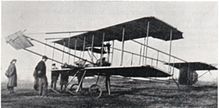- de Havilland Iris
-
Iris de Havilland Iris Type Piston aero engine Manufacturer Iris Motor Company, Willesden First run 1909 Major applications de Havilland Biplane No. 1
de Havilland Biplane No. 2Number built 6 Unit cost £250 The de Havilland Iris was a British four-cylinder, liquid-cooled, horizontally-opposed aero engine. Notable as the first aero engine to be designed by Geoffrey de Havilland it was produced in small numbers between 1909 and 1910 by the Iris Motor Company of Willesden from which it took its name.
Contents
Design and development
By 1908 Geoffrey de Havilland had designed and built two motorcycle engines and his first aircraft, the de Havilland Biplane No. 1. He had studied the engine used by the Wright brothers and believed that he could design a similar unit with an improved power-to-weight ratio. Whilst working as a designer for the Motor Omnibus Construction Company in London he produced drawings for his new engine over a period of three to four months and commissioned the Iris Motor Company, where his brother Ivon de Havilland had been the Chief Designer, to build the first prototype at a cost of £250.[1]
The design featured a horizontally-opposed, four-cylinder layout with a single camshaft operating poppet valves through pushrods that were hollowed to save weight. The crankshaft was supported on ball bearings which allowed a simple 'splash' lubrication system to be used. Cooling was by water with the cylinders being encased in copper jackets. Although the engine ran well, it was not placed into production. The only order was a small contract from the British Government for use in airships.[2]
1957 replica
In 1957 instructors and apprentices from the de Havilland Aircraft Company Technical School decided to construct a replica engine, almost 50 years after the original Iris was built. The Iris Motor Company had long since closed and its records, along with the original engine drawings, were destroyed by German bombing during World War II. Flight magazine had featured an article on the engine in May 1910 with a detailed technical description and line drawings. This information along with the original designer's memory were used to produce a new set of drawings and components. Several companies involved with the original engine assisted with new parts, Claudel-Hobson supplied the carburettor, Lodge Plugs Ltd the spark plugs and Simms Motor Units assisted with re-conditioning a magneto that had been borrowed from the London Science Museum.[3]
Connected to a lathe via a belt drive, the engine started at the first attempt in May 1961 and idled steadily at 2-300 rpm. It is reported that the engine was then displayed in the showroom of the de Havilland Engine Company at Leavesden.[3]
Applications
- de Havilland Biplane No. 1
- de Havilland Biplane No. 2
- Government Balloon Factory Gamma
Specifications (Iris)
Data from Lumsden and Flight[4][5]
General characteristics
- Type: 4-cylinder liquid-cooled horizontally-opposed piston aircraft engine
- Bore: 4.5 in (114 mm)
- Stroke: 4.75 in (120 mm)
- Displacement: 301.46 cu in (4.94 L)
- Dry weight: 250 lb (113 kg)
Components
- Valvetrain: Overhead valve
- Fuel system: Carburettor
- Fuel type: Petrol
- Cooling system: Water-cooled, thermo-siphon system
Performance
- Power output: 45 hp (33.5 kW) at 1,500 rpm
- Specific power: 0.15 hp/cu in (6.8 kW/L)
- Power-to-weight ratio: 0.18 hp/lb (0.3 kW/kg)
See also
- Comparable engines
- Green C.4
- Related lists
References
Notes
Bibliography
- Gough, Edward. A. The first D.H. engine. Flight, 27 July 1956.
- Lumsden, Alec. British Piston Engines and their Aircraft. Marlborough, Wiltshire: Airlife Publishing, 2003. ISBN 1-85310-294-6.
- McKay, Stuart. The Moth - Magazine of the de Havilland Moth Club, No. 150. de Havilland Moth Club Ltd. Berkhamsted, Hertfordshire. June 2010.
de Havilland aero engines Piston engines Ghost · Gipsy · Gipsy Junior · Gipsy Minor · Gipsy Major · Gipsy Six · Gipsy Queen · Gipsy Twelve · Gipsy King · Iris
Turbojet Ghost · Goblin · Gyron · Gyron Junior
Turboprop/turboshaft Rocket Designers Lists relating to aviation General Aircraft (manufacturers) · Aircraft engines (manufacturers) · Airlines (defunct) · Airports · Civil authorities · Museums · Registration prefixes · Rotorcraft (manufacturers) · TimelineMilitary Accidents/incidents Records Categories:- De Havilland aircraft engines
- Aircraft piston engines 1900-1909
- Boxer engines
Wikimedia Foundation. 2010.


